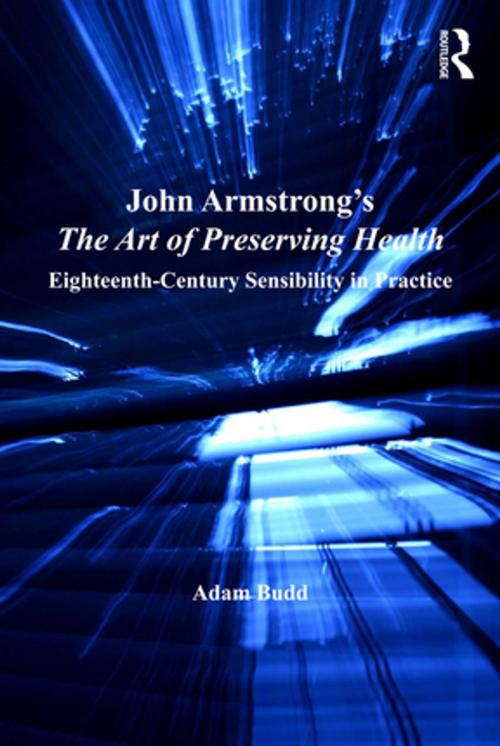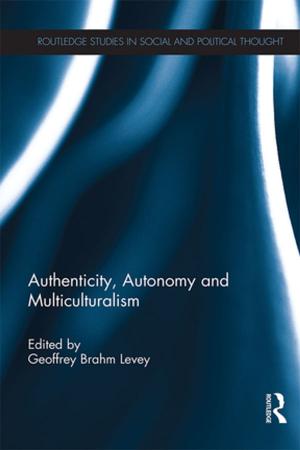John Armstrong's The Art of Preserving Health
Eighteenth-Century Sensibility in Practice
Nonfiction, Health & Well Being, Medical, Reference, History| Author: | Adam Budd | ISBN: | 9781317110798 |
| Publisher: | Taylor and Francis | Publication: | May 6, 2016 |
| Imprint: | Routledge | Language: | English |
| Author: | Adam Budd |
| ISBN: | 9781317110798 |
| Publisher: | Taylor and Francis |
| Publication: | May 6, 2016 |
| Imprint: | Routledge |
| Language: | English |
John Armstrong's 2000-line poem The Art of Preserving Health was among the most popular works of eighteenth-century literature and medicine. It was among the first to popularize Scottish medical ideas concerning emotional and anatomical sensibility to British readers, doing so through the then-fashionable georgic style. Within three years of its publication in 1744, it was in its third edition, and by 1795 it commanded fourteen editions printed in London, Edinburgh, Dublin, and Benjamin Franklin's shop in Philadelphia. Maintaining its place amongst more famous works of the Enlightenment, this poem was read well into the nineteenth century, remaining in print in English, French, and Italian. It remained a tribute to sustained interest in eighteenth-century sensibility, long after its medical advice had become obsolete and the nervous complaints it depicted became unfashionable. Adam Budd's critical edition includes a comprehensive biographical and textual introduction, and explanatory notes highlighting the contemporary significance of Armstrong's classical, medical, and social references. Included in his introduction are discussions of Armstrong's innovative medical training in charity hospitals and his close associations with the poet James Thomson and the bookseller Andrew Millar, evidence for the poem's wide appeal, and a compelling argument for the poem's anticipation of sensibility as a dominant literary mode. Budd also offers background on the 'new physiology' taught at Edinburgh, as well as an explanation for why a Scottish-trained physician newly arrived in London was forced to write poetry to supplement his medical income. This edition also includes annotated excerpts from the key literary and medical works of the period, including poetry, medical prose, and georgic theory. Readers will come away convinced of the poem's significance as a uniquely engaging perspective on the place of poetry, medicine, the body, and the book trade in the literary history of eighteenth-century sensibility.
John Armstrong's 2000-line poem The Art of Preserving Health was among the most popular works of eighteenth-century literature and medicine. It was among the first to popularize Scottish medical ideas concerning emotional and anatomical sensibility to British readers, doing so through the then-fashionable georgic style. Within three years of its publication in 1744, it was in its third edition, and by 1795 it commanded fourteen editions printed in London, Edinburgh, Dublin, and Benjamin Franklin's shop in Philadelphia. Maintaining its place amongst more famous works of the Enlightenment, this poem was read well into the nineteenth century, remaining in print in English, French, and Italian. It remained a tribute to sustained interest in eighteenth-century sensibility, long after its medical advice had become obsolete and the nervous complaints it depicted became unfashionable. Adam Budd's critical edition includes a comprehensive biographical and textual introduction, and explanatory notes highlighting the contemporary significance of Armstrong's classical, medical, and social references. Included in his introduction are discussions of Armstrong's innovative medical training in charity hospitals and his close associations with the poet James Thomson and the bookseller Andrew Millar, evidence for the poem's wide appeal, and a compelling argument for the poem's anticipation of sensibility as a dominant literary mode. Budd also offers background on the 'new physiology' taught at Edinburgh, as well as an explanation for why a Scottish-trained physician newly arrived in London was forced to write poetry to supplement his medical income. This edition also includes annotated excerpts from the key literary and medical works of the period, including poetry, medical prose, and georgic theory. Readers will come away convinced of the poem's significance as a uniquely engaging perspective on the place of poetry, medicine, the body, and the book trade in the literary history of eighteenth-century sensibility.















